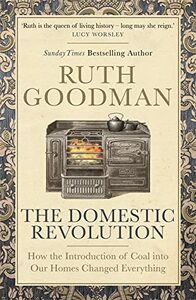Take a photo of a barcode or cover
informative
inspiring
reflective
medium-paced
I am a huge fan of Ruth Goodman's books. Every single one that I have read has proved to be interesting and educational, while being hugely entertaining at the same time - not an easy feat, dear reader. If you have not come across her books before, I can highly recommend them all, although How to be a Tudor is my favourite, being more than a little obsessed with the Tudors as I am. So I was really looking forward to diving into The Domestic Revolution and seeing what Ruth could teach me once more.
This time, Ruth sets her sights on examining how the introduction of coal into our homes sparked a complete revolution in the way we live, bringing about unprecedented changes that have helped create the world we know today.
She starts by looking at the former reliance on wood as a fuel, including going into detailed explanations of how woodland was managed to supply the demand for heating our homes, cooking our food and a variety of industrial uses for hundreds of years.
Around 1570, London's households began to change to burning coal instead of wood, as it was becoming increasingly more difficult and expensive to proved enough wood for the rising population. In just 30 years, London became a coal-fired city, and this brought about a complete change in not only the way people lived, but also the rural and urban landscapes.
What seems a simple domestic change in terms of the fuel people used brought about enormous social change, and as is Ruth Goodman's forte she guides the reader through what came next in a way that keeps you glued to the page. Coal not only served to become a new way of heating, but influenced structural home design; the way people interacted with each other within the home; the furnishings and furniture they used; the kind of food they ate and the way they cooked it; and even the way they cleaned their homes and did their laundry. There were also much wider ramifications leading to changes in the rural landscape as the demand for wood decreased; the development of a better transport network to get coal from mining areas to where it was needed; a whole different look and feel to the urban skyline as building design transformed; and even an improved Naval force (bizarre, but true)!
Parts of this book are necessarily information heavy, especially in the first couple of chapters, but they serve a useful purpose in providing a foundation for what comes later, and what comes later is utterly fascinating. Yet again, Ruth Goodman takes a subject and transforms what could be a boring litany of facts into an informative and engrossing account of something that could be considered a trivial domestic alteration by some, but was actually a catalyst for real social change for everyone.
This time, Ruth sets her sights on examining how the introduction of coal into our homes sparked a complete revolution in the way we live, bringing about unprecedented changes that have helped create the world we know today.
She starts by looking at the former reliance on wood as a fuel, including going into detailed explanations of how woodland was managed to supply the demand for heating our homes, cooking our food and a variety of industrial uses for hundreds of years.
Around 1570, London's households began to change to burning coal instead of wood, as it was becoming increasingly more difficult and expensive to proved enough wood for the rising population. In just 30 years, London became a coal-fired city, and this brought about a complete change in not only the way people lived, but also the rural and urban landscapes.
What seems a simple domestic change in terms of the fuel people used brought about enormous social change, and as is Ruth Goodman's forte she guides the reader through what came next in a way that keeps you glued to the page. Coal not only served to become a new way of heating, but influenced structural home design; the way people interacted with each other within the home; the furnishings and furniture they used; the kind of food they ate and the way they cooked it; and even the way they cleaned their homes and did their laundry. There were also much wider ramifications leading to changes in the rural landscape as the demand for wood decreased; the development of a better transport network to get coal from mining areas to where it was needed; a whole different look and feel to the urban skyline as building design transformed; and even an improved Naval force (bizarre, but true)!
Parts of this book are necessarily information heavy, especially in the first couple of chapters, but they serve a useful purpose in providing a foundation for what comes later, and what comes later is utterly fascinating. Yet again, Ruth Goodman takes a subject and transforms what could be a boring litany of facts into an informative and engrossing account of something that could be considered a trivial domestic alteration by some, but was actually a catalyst for real social change for everyone.
informative
slow-paced
informative
slow-paced
informative
slow-paced
A little drier than much narrative history these days, this is great if you love the minutiae of history. That said, it takes more than half the book to get to the promised Victorian Times of the title - she starts with a chapter on peat fires, then a chapter on wood fires, then you learn how the design of hearths change, there are little jaunts off topic to discuss washing up. Delightful for the patient reader, but not what you think you're reading.
slow-paced
Informative, but seemed to lack an engaging narrative voice to deliver information.
informative
lighthearted
reflective
medium-paced
Ruth Goodman’s books are amazing not only because she’s done the research, but because she’s lived the history. No, she’s not immortal or a time-traveler, Goodman’s spent her career trying out historical methods of living to see how they work. Because of her unique perspective, Goodman adds to the conversation about the domestic revolution and how it influenced all of society.
The choice made by regular people to switch from wood-fire to coal had multiple domino effects in society. Reading nonfiction does not come naturally to me, so I struggled through the first half, but I stayed with it because of the amazing anecdotes Goodman writes which give a practical human account of what it’s like to cook with over a dung fire or to clean laundry with wood ash and lye. The second half of the book pulled me in more and I was fascinated by the effects switching to coal had on cooking and what meals and methods were used, and the impact it had on cleaning. The Domestic Revolution shows that Goodman’s practical knowledge about history goes beyond telling readers how people lived in a certain era, it also can add to academic conversations by elevating the perspectives of everyday men and women in history whose choices in daily life affected society, but whose voices are rarely heard.
The choice made by regular people to switch from wood-fire to coal had multiple domino effects in society. Reading nonfiction does not come naturally to me, so I struggled through the first half, but I stayed with it because of the amazing anecdotes Goodman writes which give a practical human account of what it’s like to cook with over a dung fire or to clean laundry with wood ash and lye. The second half of the book pulled me in more and I was fascinated by the effects switching to coal had on cooking and what meals and methods were used, and the impact it had on cleaning. The Domestic Revolution shows that Goodman’s practical knowledge about history goes beyond telling readers how people lived in a certain era, it also can add to academic conversations by elevating the perspectives of everyday men and women in history whose choices in daily life affected society, but whose voices are rarely heard.
adventurous
informative
reflective
medium-paced





